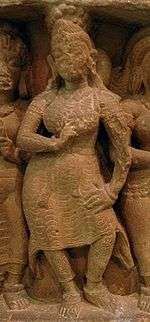Churidar
Churidars (Hindi: चुडीदार)(Urdu: چُوڑی دار), (Punjabi: ਚੂੜੀਦਾਰ), or more properly churidar pyjamas (ਚੂੜੀਦਾਰ ਪਜਾਮਾ), are tightly fitting trousers worn by both men and women in the Indian Subcontinent. Churidars are a variant of the common salwar pants. Salwars are cut wide at the top and narrow at the ankle. Churidars narrow more quickly, so that contours of the leg are revealed. They are usually cut on the bias, making them naturally stretchy. Stretch is important when pants are closefitting. They are also longer than the leg and sometimes finish with a tightly fitting buttoned cuff at the ankle. The excess length falls into folds and appears like a set of bangles resting on the ankle (hence 'churidar'; 'churi': bangle, 'dar': like). When the wearer is sitting, the extra material is the "ease" that makes it possible to bend the legs and sit comfortably. The word churidar is from Hindi and made its way into English only in the 20th century.[1] Earlier, tight fitting churidar-like pants worn in India were referred to by the British as Moghul breeches, long-drawers, or mosquito drawers.[2]
The churidar is usually worn with a kameez (tunic) by women or a kurta (a loose overshirt) by men, or they can form part of a bodice and skirt ensemble.
Gallery
-

Ancient form of Angrakha and Churidar worn during the Gupta period.
-

PM Narendra Modi is renowned for wearing churidars.[1]
-

Actors Karisma Kapoor & Kareena Kapoor in churidars.
-

Portrait of Kashmiri children wearing churidar pyjamas circa 1890
-

19th century Indian women wearing transparent skirts over churidar pants
-

Vita in Bangladesh wearing Churidar
See also
References
- ↑ Hawkins, R. E. 1984. Common Indian words in English. Oxford University Press, New Delhi.
- ↑ Yule, Henry and A. C. Burnell. 1903. Hobson-Jobson: A Glossary of Colloquial Anglo-Indian Words and Phrases, and of Kindred Terms, Etymological, Historical, Geographical and Discursive. London: John Murray. 1021 pages.